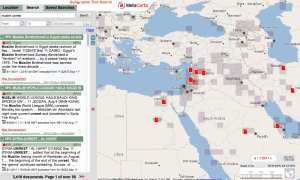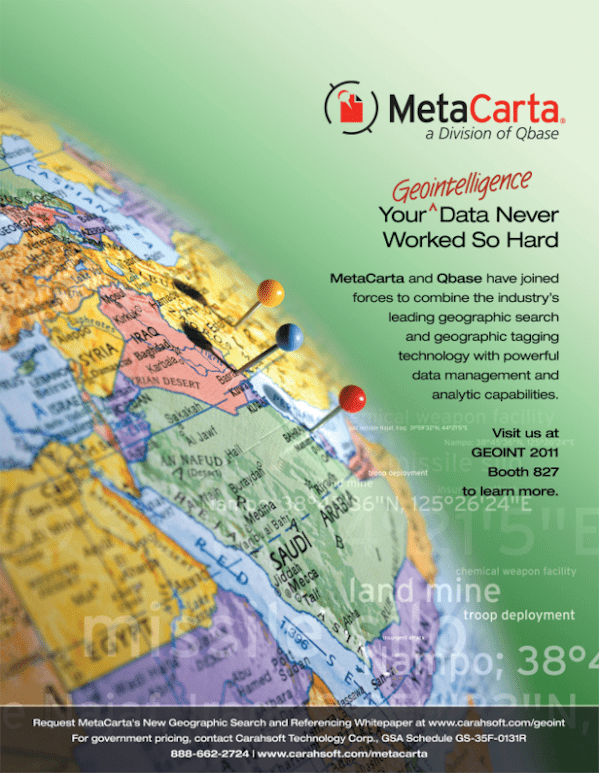In a world that's increasingly influenced by nontraditional, disparate data, as well as open source information channels, the Department of Defense (DoD) continues to lack the critical ability to rapidly synthesize and aggregate information at scale to fully understand how new data affects current data. In fact, finding new ways and technologies to increase the speed and accuracy of battlefield operations by providing warfighters with efficiently synthesized and aggregated information is an ongoing challenge for agencies throughout the U.S. government.
As the volume of data grows and the public's adoption of open source and social media expands, data fusion becomes an area of vital importance as it relates to security, defense and social unrest in the United States and abroad.

MetaCarta geosearch and geographic referencing software makes geographic information actionable with geographic text search and content referencing.
Tackling the Data and
Analysis Challenge
Combatant commands and the intelligence community (IC) have billions of unstructured internal and open-source documents at their disposal, as well as scores of aerial- and ground-based sensor data. But to be useful, all of that data must be correlated, tagged, indexed and plotted on a geolocational common operating picture. As every analyst knows, unless the geolocation is embedded in the data stream, finding the correct geography is an arduous, time-consuming process that delays the analysis cycle.
Distilling place names quickly and building human terrain layers to understand context isn't easy to accomplish. However, several DoD and IC elements are finding success applying geotagging, geoindexing, geosearch and geolocation technologies from MetaCarta, a division of Qbase. These solutions are enabling analysts to combine nontraditional structured and unstructured data from numerous sources and then tie everything to points on the ground to better describe, visualize and understand the battle space.
When analysts deal with highly structured and well-formatted data it leads to a high success rate for understanding associations and relationships between disparate human terrain data elements, says Lt. Col. (Ret.) Al Di Leonardo, an expert in the application of human terrain analysis and the recipient of a 2011 Federal 100 Award for innovation within a combatant command.
Contextualizing and Converging Data
MetaCarta enables human terrain analysis by contextualizing information pertaining to the location of events, activities, people and organizations. Population, geographic hierarchies and geospatial relationships are gleaned from textual material based on concepts such as unrest, shortages and cultural differences. Such concepts are used to build cultural models. Because these cultural models depend on sentiment over time, making sense of temporal data is critical to understanding historical data. MetaCarta enables near real-time geographic quantization of data assets to keep the analysis models nimble in urgent circumstances.
To effectively dismantle threat networks and narrow the search space for our warfighters, a combatant command must be able to aggregate and synthesize information in near real time, said Di Leonardo at a recent U.S. Geospatial Intelligence Foundation GEOINT Conference. Otherwise, it will never be able to conduct the analysis needed to understand new human terrain data against the backdrop of its historical data at the speed required to solve today's socio-cultural challenges.
DoD and IC analysts now use MetaCarta's technology to rapidly ingest millions of unstructured text documents, disambiguating and extracting precise geolocational information to leverage the system's 27 million known place names and overlaying these findings on geospatial entity maps containing the DoD's live sensor feeds. In advance of key campaigns, DoD strategists gain tactical advantage by accessing converged text and sensor-based data from a single, central location. Likewise, forensic specialists use the correlated information to identify past situational determinants and to mitigate future risks.
MetaCarta is honored that our technology is helping agencies build dynamic models to support their missions and leverage data as a weapon against terrorism, said MetaCarta Senior Vice President Ken Tomaselli. Nothing makes this company prouder than its continued support of American warfighters and their coalition partners.
For more information, visit MetaCarta at www.carahsoft.com/geoint


